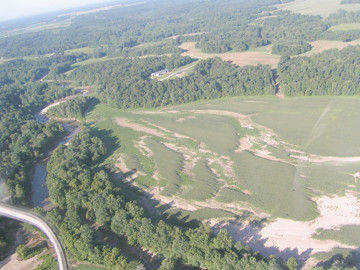County receives disaster funds

Putnam County is one of nine counties to receive money from the 2008 Indiana Natural Disaster Fund. The Putnam County Soil and Water Conservation District (SWDC) received a grant of $161,150 to correct flood damage in the Big Walnut Creek Water Shed Alliance.
The grants come from the 2008 Indiana Natural Disaster Fund, established with a $45 million grant from the Lilly Endowment, Inc. to the Indiana Association of United Ways.
The total of the grants in Cycle 4 of Round 2 funding for the state is $15,838,663.
A local committee was formed through the Putnam County United Way to propose projects ranging from assisting individuals rebuild homes to reconstructing or repairing public facilities.
The SWCD worked with the Natural Resources Conservation Service (USDA) and Big Walnut Creek Water Shed Alliance in specifying damage and measures the costs to be incurred to assist in correcting flood damage.
"Without Sue Crafton and Matt Jarvis, there wouldn't be a funded project," Local Committee Chairman Dick Andis told the Banner Graphic. "There was great collaboration among many agencies and committees to make this happen."
The June 2008 flood altered the natural course of the waterways in Putnam County. Large amounts of soil and vegetation were deposited into these channels, and watercourses were plugged by sediment and debris.
Increased flooding from rainfall will occur without corrective actions. Sedimentation of exposed areas will continue. Farmland surface and subsurface drainage courses are blocked and sealed off as a result of sediment deposits.
Agricultural production has been reduced. Roger Bailey, County Executive Director with the Farm Service Agency has documented damages on these sites.
"Cropland productivity has been and will continue to be hindered by the flooding and deposition of sand and debris," said Bailey.
Landowners are also contributing to the restoration efforts to the tune of $104,250.
The SWCD and Natural Resources Conservation Service will be working to develop a process to provide cost-share to agricultural producers who suffered damage from the flood using the 2008 Indiana Natural Disaster Fund.
Putnam County SWCD will also be working with the county commissioners and highway department to identify key areas for restoration and repair near county roads and bridges.
"The bridges project, along with several other projects throughout the state, are still viable but suspended pending other state and federal opportunities that may arise," said Andis.
The Flood Plain Assessment Study completed by V3 COMPANIES, Empower Results LLC and Putnam County SWCD has determined many of the sites. This study was completed with funds awarded to Putnam County in Round 1 of the IND Fund.
"It takes time for people and communities to recover from one of the worst Indiana disasters in 100 years," said Larry Welker, IND Fund chairman and IAUW board member.
"Our reviews recognize a range of recovery work that is needed even a year after flooding. We have worked hard to coordinate with the state and other funding sources," he added.
Counties receiving funding in the fourth cycle of Round 2 include:
Bartholomew County, $4,393,892 for equipment at the community hospital
Clay County up to $340,000 for documented levee work
Jefferson County, $13,900 for work on historic sites
Lake, Porter and LaPorte Counties $10,219,235 for individual assistance
Monroe County, $300,000 or individual assistance
Putnam County, $161,150 for agricultural stabilization and drainage
Rush County, $410,486 for historic sites and public facilities
Additional projects in six counties, including Putnam, have been tabled pending resolution of other funding sources.
"Indiana's recovery efforts are large and ongoing," said Roger Frick, IAUW president. "Over 7,500 volunteers have been engaged in flood recovery work across the state in the last 12 months. There are long term recovery committees still at work in over 10 counties. Homes, roads, sewers and community landmarks all still need attention."
Factors determining grant awards include local needs, available resources, the scale and type of damage, local demographics and other funding commitments. Applications are based on the recommendations of local United Ways or community foundations that work with other local groups to set priorities for the funds.
For information about the IND Fund projects contact Dick Andis at 720-1342 or e-mail him at randis@broadreach.net
